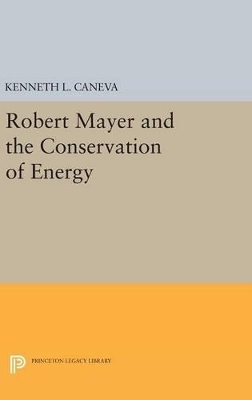
Robert Mayer and the Conservation of Energy
Princeton University Press (Verlag)
978-0-691-63435-7 (ISBN)
- Lieferbar (Termin unbekannt)
- Versandkostenfrei innerhalb Deutschlands
- Auch auf Rechnung
- Verfügbarkeit in der Filiale vor Ort prüfen
- Artikel merken
The intellectual environment treated here embraces medicine, physiology, physics, chemistry, religion, and spiritualism. Kenneth L. Caneva is Associate Professor of History at the University of North Carolina, Greensboro. Originally published in 1993. The Princeton Legacy Library uses the latest print-on-demand technology to again make available previously out-of-print books from the distinguished backlist of Princeton University Press. These editions preserve the original texts of these important books while presenting them in durable paperback and hardcover editions. The goal of the Princeton Legacy Library is to vastly increase access to the rich scholarly heritage found in the thousands of books published by Princeton University Press since its founding in 1905.
AcknowledgmentsAuthor's NoteIntroductionPt. IThe Man and His Work1Ch. 1Mayer the Person31Mayer's Upbringing and Education32Mayer's Voyage to the Dutch East Indies73Mayer's Religiosity84Mayer's Circle of Friends145Mayer's Character16Ch. 2Mayer's Work181Mayer's Earliest Presentation of His Ideas191.1"On the Quantitative and Qualitative Determination of Forces"191.2"Remarks on the Forces of Inanimate Nature"232The Leading Ideas and Peculiarities of Mayer's Work252.1Force252.2Neutralization of Differences: The Continued Importance of Chemical Analogs332.3Causality and the Laws of Thought352.4Quantitative Thinking and the Measure of the Equivalence of Heat and Motion372.5The Measure of Force382.6Mayer's Restriction of His Ideas to Inanimate Nature and His Allowance for the Creation of Force Out of Nothing412.7Force as an Antidote to Materialism432.8The Search for Valid Analogies46Pt. IIEstablishing the Relevant Context47Ch. 3Physiology and Medicine491Blood, Respiration, and Animal Heat492Sources of Organic Activity682.1Physical and Chemical Processes: The Organism's Connection with the External World702.2Vital Forces and the Soul: The Organism's Internal Sources of Activity793Leading Analogies1253.1The Relationship between the Imponderables, Vital Force, and the Soul1263.2Organisms as Machines1423.3The Solar System as a Living Organism1454Physiology as an Opponent of Materialism1505Homeopathy152Ch. 4Physics and Chemistry1601Force1611.1The Parallelogram of Forces and Central-Force Motion1681.2Catalytic, Contact, and Electrochemical Forces1732Imponderables and the Nature of Heat1842.1Thermal Expansion of Gases and Related Phenomena1923Matter1944Metamorphosis, Neutralization, and Indifference: The Chemical and Physical Contexts198Ch. 5Science Circumscribed2071The Nature and Scope of Science2082Religion and Spiritualism219Pt. IIIMayer's Work in Context231Ch. 6A Contextual Reconstruction of the Development of Mayer's Ideas2331Through the Publication of His 1842 Paper2352Later Developments and Changing Emphases259Ch. 7Mayer and Naturphilosophie2751The Leading Characteristics of Naturphilosophie2822Force and Forces in Naturphilosophie2872.1Vital Force2993Respiration and Animal Heat3044Echoes of Naturphilosophie in Mayer's Work?309Ch. 8Assessment and Conclusions320Appendix One: Timeline of Robert Mayer's Life and Work329Appendix Two: Courses Mayer Took at the University of Tubingen, 1832-37332Appendix Three: The German Text of the Longer Passages Quoted from Manuscript335Notes341Bibliography395Index425
| Erscheinungsdatum | 27.05.2016 |
|---|---|
| Reihe/Serie | Princeton Legacy Library |
| Verlagsort | New Jersey |
| Sprache | englisch |
| Maße | 152 x 235 mm |
| Gewicht | 822 g |
| Themenwelt | Naturwissenschaften ► Physik / Astronomie ► Mechanik |
| ISBN-10 | 0-691-63435-1 / 0691634351 |
| ISBN-13 | 978-0-691-63435-7 / 9780691634357 |
| Zustand | Neuware |
| Informationen gemäß Produktsicherheitsverordnung (GPSR) | |
| Haben Sie eine Frage zum Produkt? |
aus dem Bereich


